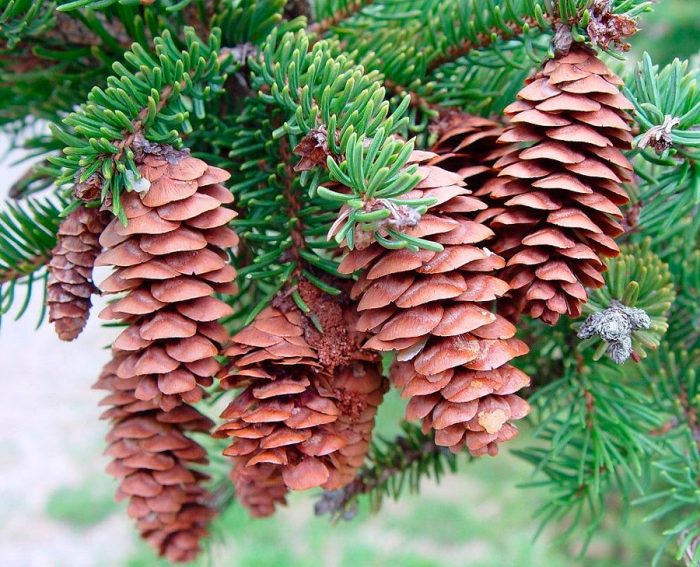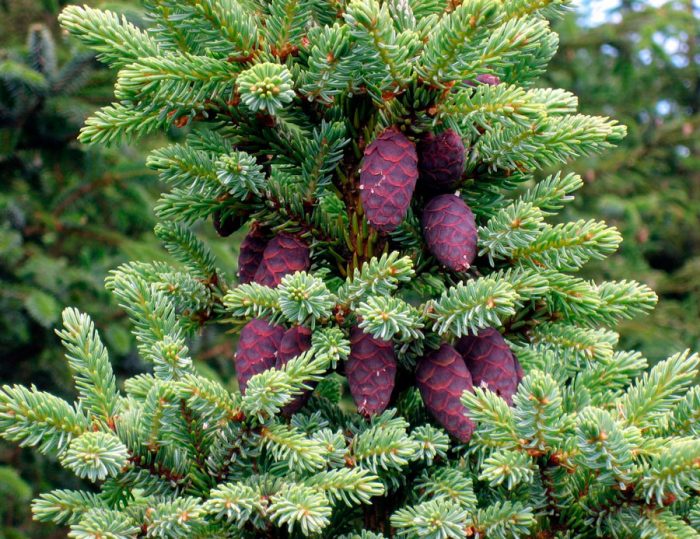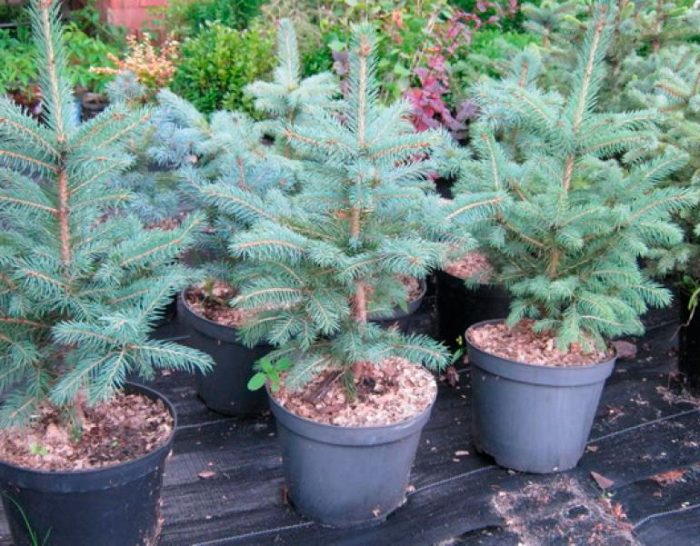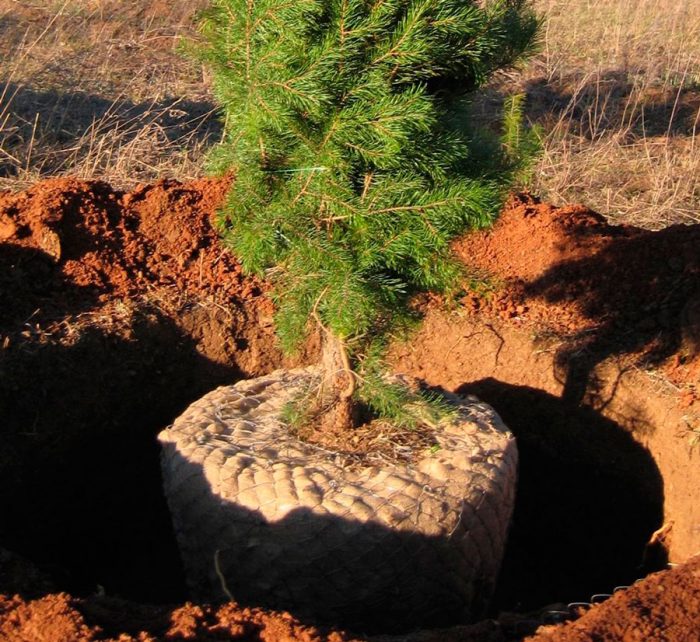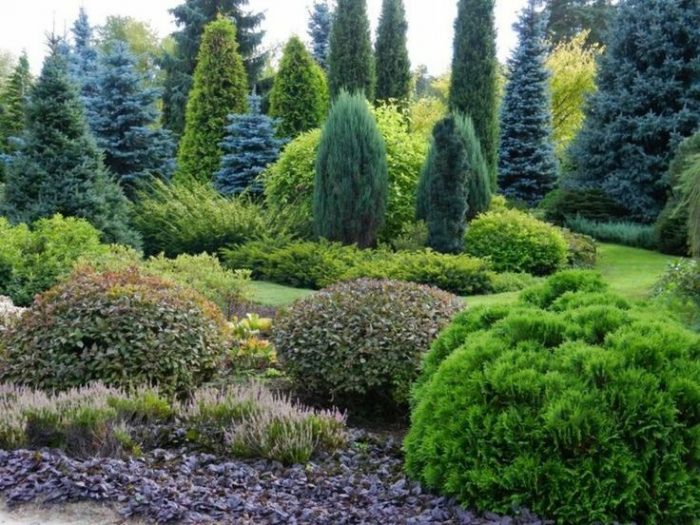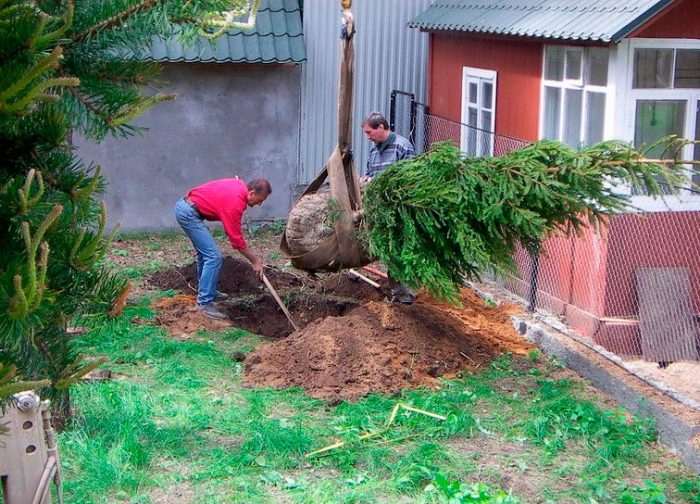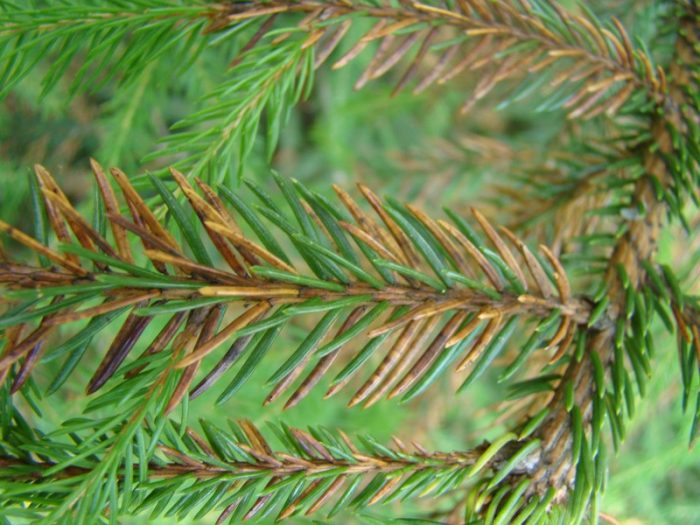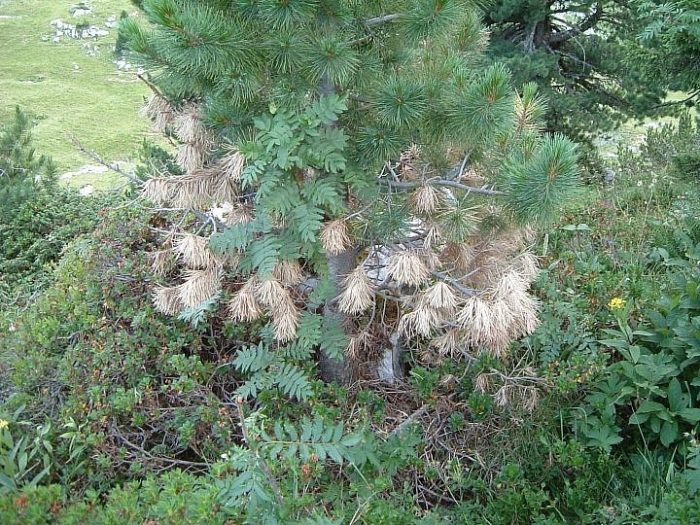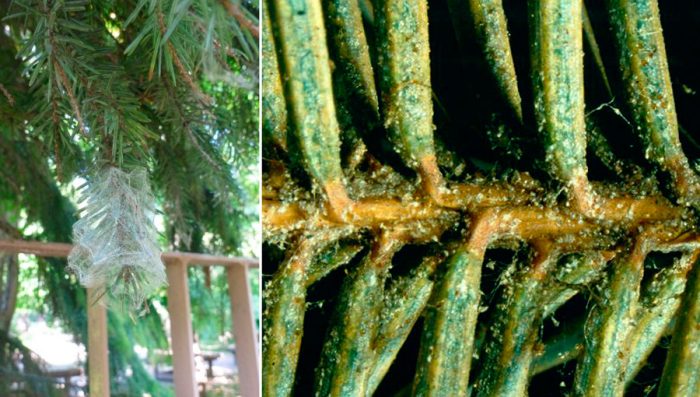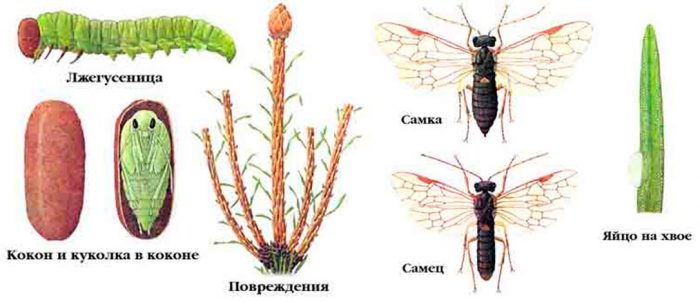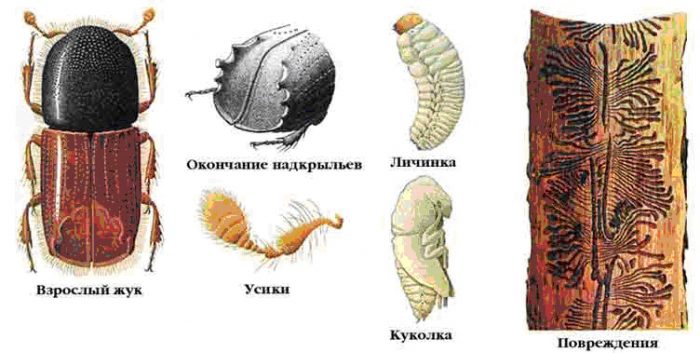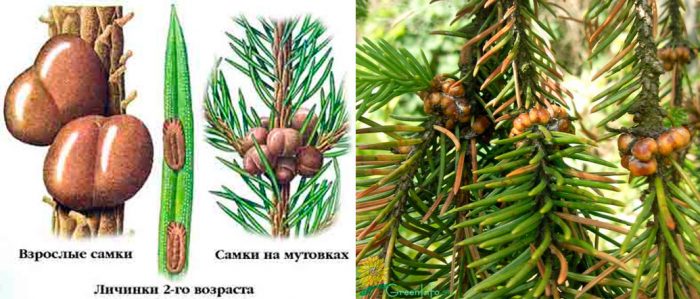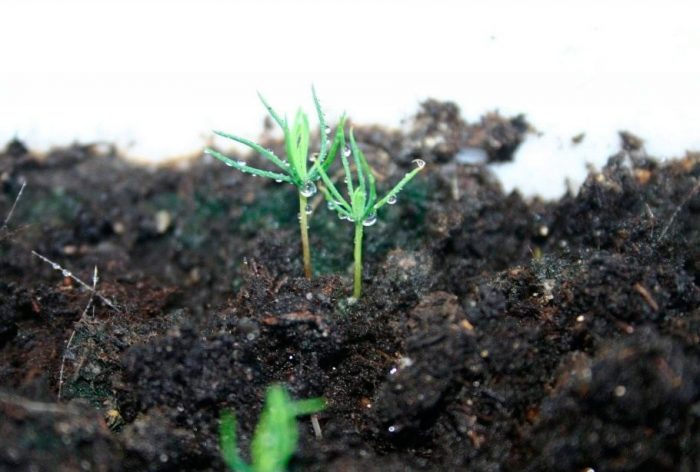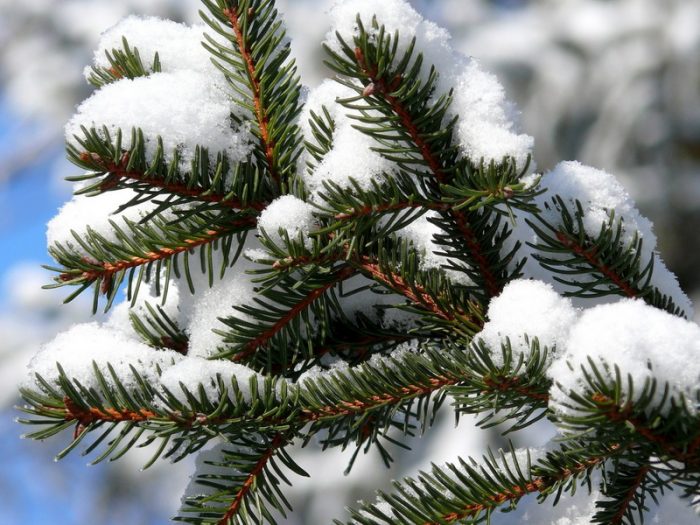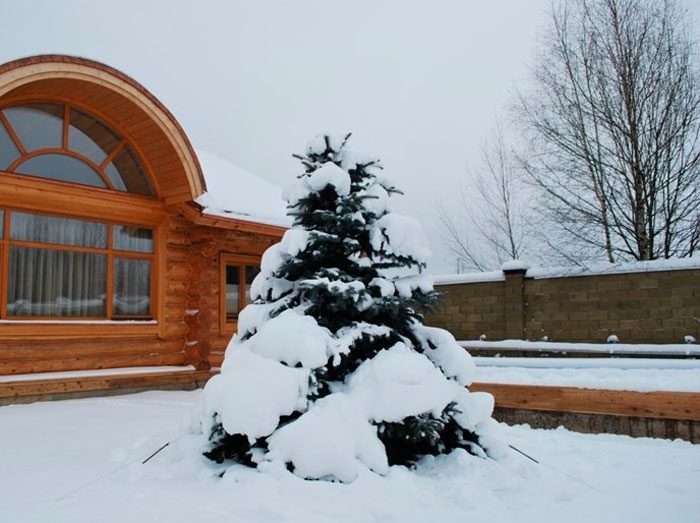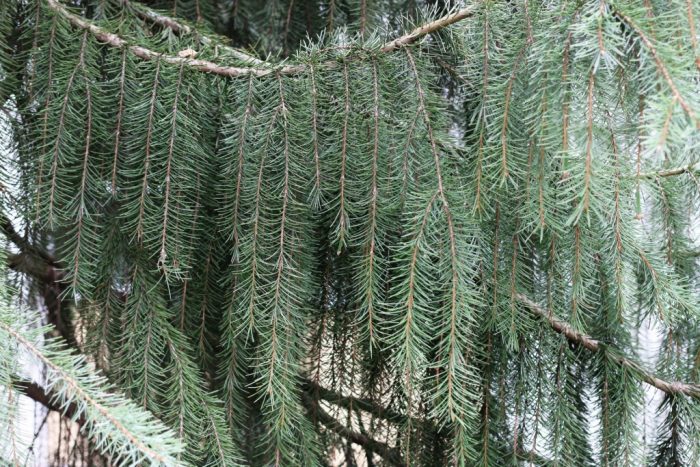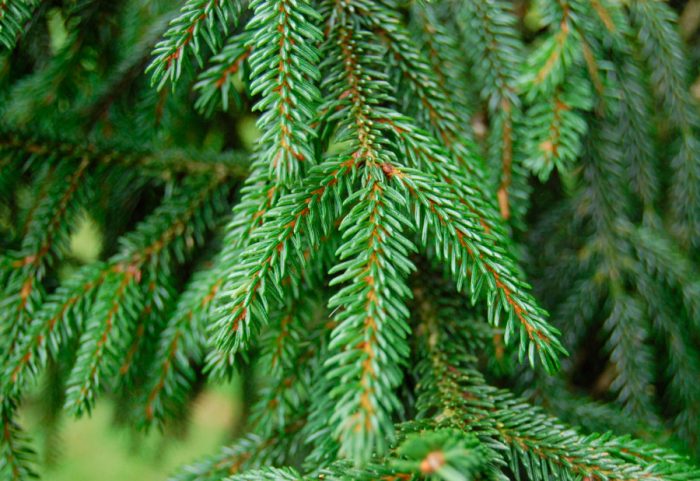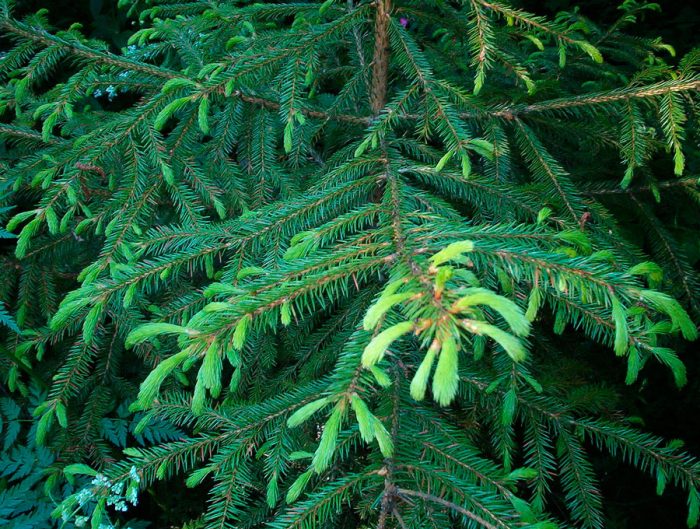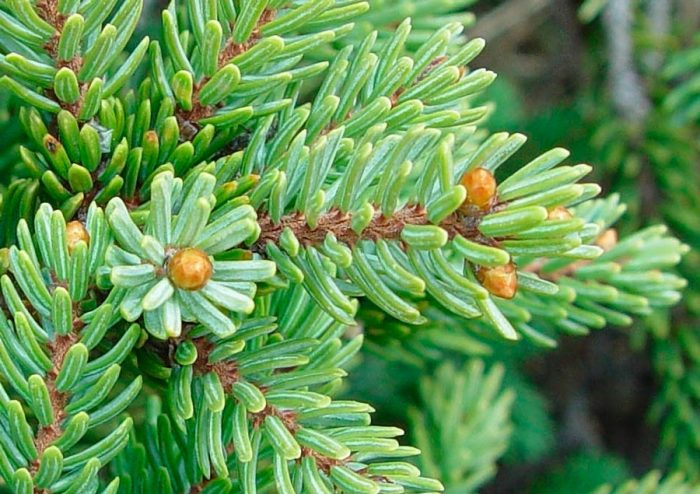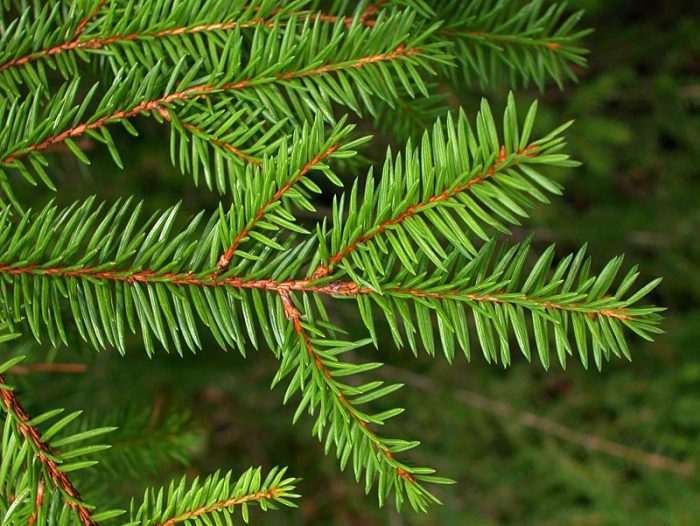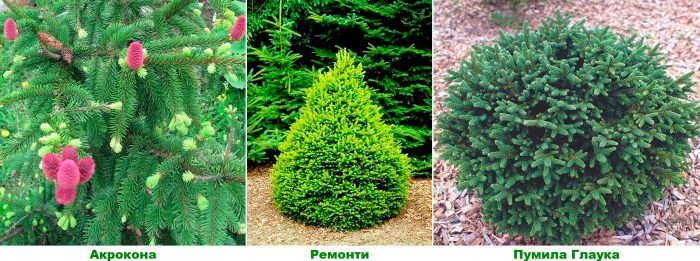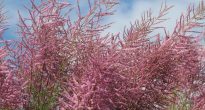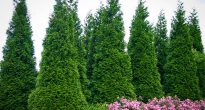The spruce tree (Picea) is a member of the Pine family. This genus unites about 40 species. The Latin name for this plant comes from the word "pix" which translates as "resin". And the Russian name of this genus comes from the word referring to the Proto-Slavic language, it has the same meaning as “pix”. The most common species of this genus is common spruce (European). In the western part of Sweden, in Fulufjellet National Park, there is a spruce belonging to this species, it is more than 9550 years old. It is the oldest arboreal organism on planet Earth. Probably everyone knows that this tree is considered the main symbol of the New Year and Christmas.
Content
Spruce features
Spruce is an evergreen monoecious tree that is distinguished by its slenderness. In height, it can reach 40 meters or more. During the first 10–15 years, the root system of such a plant is pivotal. Then the death of the main root is observed, and the tree continues to live at the expense of the roots, which are superficial and are located within a radius of 15 to 20 meters from the trunk. Due to the surface system of roots, spruce is classified as unstable, or rather, windfall trees. The crown has a conical or pyramidal shape. Whorled branches are horizontally spreading or drooping. During the first few years, the plant does not show the growth of lateral shoots. The bark is gray; it exfoliates from the trunk in thin plates. This culture has needle-shaped needles. Short hard sharp needles, as a rule, are tetrahedral, but there are also flat ones. They are arranged in a spiral manner, in some cases in two rows, while the lifespan of one needle is about 6 years, and sometimes even longer. Every year the plant loses up to 1/7 of its needles.
These trees are gymnosperms.Male strobila are represented by small earrings growing from the sinuses located at the tips of last year's branches, the beginning of pollen production occurs in May. Female strobiles are also placed at the ends of branches, they are pollinated with the help of the wind, after which they are observed to grow and hang. The fall of woody or leathery cones of a pointed oblong-cylindrical shape is observed after the seeds have ripened. The cone contains an axis, and the seed and cover scales are placed on it. In October, the seeds are fully ripe, after which the cones open, and they spill out, carried by the wind in different directions. The seeds remain viable for 8-10 years. Fruiting of such trees can begin at the age of 10-60 years, it depends on the growing conditions. The average lifespan of spruce is 250–300 years, but specimens over 500 years old are quite common.
Spruce planting in open ground
What time to plant
Conifers are characterized by undemanding care and unpretentiousness to growing conditions, and also have a high decorative effect. As a result, in recent years, such trees began to be cultivated on personal plots everywhere. Spruce planting is a rather difficult process, especially if it is a large size. It is recommended to purchase seedlings with a closed root system. The fact is that such a plant reacts extremely negatively to dry roots, if they are exposed in the air, then after 15–20 minutes. will perish. Experts advise buying seedlings from nurseries or garden centers with a good reputation, and seasonal markets are very poorly suited for this. When choosing a seedling, it should be carefully examined. Pay attention to the needles, it should be glossy, rich in color and without dried needles, while the root system should not stick out from the container. A meter high seedling ready for planting in open ground must have an earthen lump, reaching at least half a meter in diameter.
It is recommended to plant a seedling in open soil in the second half of April, this can also be done in the last days of August or the first days - September, the fact is that at this time there is an intensive growth of the spruce root system, and therefore after planting it takes root much faster and easier ... Planting a seedling whose height exceeds 3 meters, experts advise to carry out in November-March, while the earthen lump must be frozen. For planting a decorative spruce that has a small size, you can choose a site located near the house. If the tree is a large-sized tree, then its superficial root system will absorb a large amount of moisture and nutrients, from which crops growing in the neighborhood will suffer. Therefore, for planting a large-sized tree, it is recommended to choose a place located outside the personal plot, otherwise it will be necessary to prune its roots every year. Forms with colored needles, as well as decorative spruces, must be planted in a well-lit area, since their decorative qualities will be lost in shading. It should also be noted that large trees grown in a sunny area have a uniformly formed crown.
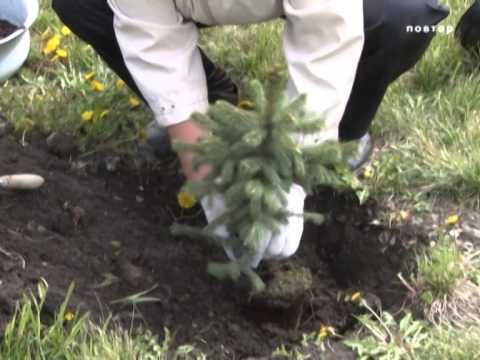

Watch this video on YouTube
Landing rules
The depth of the planting pit should be from 0.5 to 0.7 m. The lower diameter of the pit should be equal to 0.3–0.5 m, and the upper one - 0.4–0.6 m. If a site with a high groundwater or with heavy soil, then at the bottom of the pit it will be necessary to make a drainage layer 15 to 20 centimeters thick, for this you can use broken brick or crushed stone, which is sprinkled with sand.
Before you start planting, you need to prepare an earth mixture to fill the hole.To do this, it is necessary to combine the sod and deciduous land with sand, humus, peat, and also with ¾ st. Nitroammofoski. It will be very good if you replace the leafy land with forest land. 2-3 hours before planting, the root system of the seedling is immersed in water, without taking it out of the container. The drainage layer in the pit must be covered with soil mixture. Then the plant must be carefully removed from the container, while trying not to destroy the clod of earth, after which it is lowered into the planting pit. If the lump of earth collapses, then you should accelerate, since you have only a third of an hour left to complete the landing. The seedling in the pit must be installed strictly vertically, after which it is necessary to fill it with soil mixture, while it does not need to be strongly tamped. It should be noted that after planting, the root collar of the plant should be flush with the surface of the site. Around the planted tree, it is necessary to build a dump from the ground, after which 1 to 2 buckets of water must be poured into the trunk circle. After the liquid is completely absorbed into the soil, the surface of the trunk circle must be covered with a layer of mulch (peat). If the seedlings are large varieties, then when planting between them, a distance of at least 200-300 cm should be observed.
Spruce tree care in the garden
Adult spruces are distinguished by a relatively high drought resistance, they are able to withstand half a month without watering. But it should be borne in mind that miniature and dwarf varieties, as well as young trees and seedlings, especially those planted in winter, need more frequent watering. Trees planted in winter must be watered regularly throughout the first season once every 7 days, and at least 12 liters of water must be poured into the trunk circle each time. It is necessary to water the spruce carefully, because the water should not fall on the needles. To prevent the appearance of rot on the surface root system, as well as to prevent rapid evaporation of moisture from the soil, the surface of the trunk circle must be covered with a six-centimeter layer of mulch (needles, shavings of coniferous trees, bark or sawdust). You can still place decorative stones around the spruce or sprinkle expanded clay. If the soil is not mulched, then systematic loosening of its surface to a seven-centimeter depth will be required, and regular weeding will also be required.
Such a tree must be systematically fed. It should be borne in mind that if in the year of planting all the necessary fertilizers were introduced into the planting pit, then during the first season the seedling is not needed. In the following seasons, once a year, complex fertilizer for conifers must be applied to the trunk circle. After planting, seedlings, as well as transplanted trees, must first be watered with water mixed with growth-stimulating agents (Heteroauxin, Epin or Herbamin), and the needles must be treated with Ferravit. Adult specimens do not need to be fed.
Sanitary pruning of spruce should be carried out only if necessary; for this, dry and diseased branches are cut. Remember that heavy pruning can kill the tree. However, prickly spruce needs formative pruning, like lilacs, from a tree, for example, you can form a cypress.
Spruce transplant
After planting, during the first fifteen years, the tree is characterized by extremely slow growth, in this regard, in order to quickly green the site, an already mature spruce must be planted on it. In some cases, trees are transplanted, reaching a height of 15 meters, and they take root quite successfully. It is recommended to transplant such large-sized trees in the first winter weeks, the soil should already be frozen, but the air temperature should not be lower than minus 8-12 degrees. Transplanting can also be carried out in the last winter weeks, while the soil must still be frozen. The fact is that in such conditions, the soil is well kept on the root system, and therefore it is practically not injured.
Preparing the tree for transplanting should be done in advance. To do this, in spring, along the projection of the crown perimeter, it is necessary to dig a trench, the width of which should be from 0.2 to 0.3 m, and the depth of 1 m, while the roots should be carefully trimmed using a shovel. The trench must be filled with peat or humus, while fertilizer must be poured into it in order to stimulate root growth. Then the trench must be watered abundantly. During the summer period, it is necessary to water the substrate in the trenches several times, especially if there is a dry period. With the onset of the autumn period, a large number of thin roots will appear in this pillow. A pit with sheer walls should be prepared in the autumn, its depth should be 100 cm, while in diameter it should be 100 cm more than the diameter of the crown. The soil mixture prepared in advance for filling the pit is stored for storage in the basement, because it should not freeze. You also need to stock up on litter from under the tree, sand and dried foliage.
If the height of the tree does not exceed 200 cm, then you can dig it out with your own hands, for this they dig it around the radius of the trench, all the remaining roots must be chopped off. A tree at this age has roots going to a depth of 0.6 m.Therefore, it is necessary to dig the plant to such a depth. Take burlap and put it under the roots, you also need to wrap an earthen ball with it. After that, the tree is removed from the soil and delivered to a new planting pit. If the transplanted tree is higher than 200 cm, then you need to use a grubber, it is able to hold the root system together with the earthy clod as well as the crown, while not injuring them. At the bottom of the pit, a drainage layer, forest floor, and then a layer of dry leaves should be laid. Only after that the tree is placed in a planting hole, while its root collar should rise 50–70 mm above the surface of the site. It should also be noted that during the installation of the tree, its orientation in the "south-north" direction must be kept in the pit. The remaining voids in the pit must be filled with prepared earth mixture, while it only needs to be tamped a little. Then several powerful stakes are taken and driven into the ground along the perimeter of the landing pit, while the distance between them should be the same. Then a tree is tied to these stakes with stretchers, this will allow the transplanted plant not to fall from the gusts of wind. The surface of the trunk circle should be covered with a layer of peat, loose leaves, humus or spruce branches. After the soil settles in the pit, the root collar of the spruce should be flush with the surface of the site.
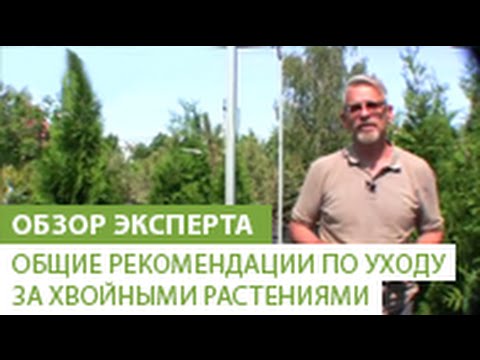

Watch this video on YouTube
Diseases and pests ate with photos
Coniferous crops differ in that they have very weak resistance to diseases and harmful insects. Below will be given a description of those diseases and pests that disturb the spruce most often.
Pine needles rust
Needle rust is a fungal disease. In the first summer weeks of an infected tree, a large number of cylindrical bubbles appear on the needles, which reach 20–30 mm in diameter and contain spores. After the spores mature, the bubble shell bursts, and they scatter and settle on the surface of nearby plants. This disease poses the greatest danger to young Christmas trees, because because of it, the needles begin to die off ahead of time. In order to cure the plant, and also to prevent its infection, in the first days of June it is sprayed with a solution of Bordeaux mixture (1%) or another fungicidal preparation of a similar action. All needles that have flown around must be systematically collected and destroyed. Do not forget to remove weeds from the site in a timely manner. Such a tree can also get sick with cone rust. The affected buds must be removed from the plant as soon as they are found.They fight such a disease in the same way as with pine needles rust.
Shute ate ordinary
Shute ate ordinary - this disease manifests itself in the spring. In affected specimens, on last year's shoots, there is a change in the color of the needles to brown, as well as its dying off. But the affected needles do not crumble, but stay on the branches until the next spring period. At this time, apothecia of the fungus are formed on the seamy surface of the needles, which look like convex glossy formations of black color. In affected specimens, growth retardation is observed, and some of them die altogether. As soon as the first symptoms of the disease are noticed, it is necessary to immediately cut off all infected branches and spray the tree with a solution of a fungicidal preparation. To cure a spruce, it will need to be processed 3 or 4 times.
Schütte brown
Shyute brown - this disease affects young trees. The needles on them turn brown-brown and dry out, however, it does not crumble, and continues to hold on to the branches for a long time. All infected branches should be removed and the tree should be sprayed with a fungicide.
Schütte spruce snow
Shütte ate snowy - the symptoms of such a disease appear in the autumn. On the surface of the needles, specks of brown-red color are formed, and a white bloom appears on them in spring. As the disease progresses, the plaque becomes dark, and fruiting bodies of a black fungus appear on its surface. Over time, the needles turn brown, dry and die off. All infected branches should be cut and destroyed. To cure a sick spruce, it must be sprayed with a solution of a fungicidal preparation several times.
Root sponge
Root sponge - this disease is widespread enough, while it affects both coniferous and deciduous trees, and leads to decay of the root system. The appearance of the fruiting bodies of the fungus is observed at the root collar, in the voids under the roots, as well as on their lower surface, and it happens that they are also located on the litter near the plant. Such leathery formations can vary in size and shape, their surface is colored brown or brown, while inside they are yellowish or white. Their texture is similar to soft cork. In a diseased plant, all foci of spread of the disease must be cut out, while the affected areas need to be treated with a fungicide solution.
Spider mite
Spider mite - this arachnid poses the greatest danger to the tree. In hot and dry times, this pest is most active. The tick sucks out the cell sap from the tree. The fact that this pest has settled on the plant can be understood by the presence of a cobweb and by the many small dots on the surface of the needles. If there are a lot of ticks, then the tree begins to turn yellow, and the needles on which such arachnids are located turn into a lighter, almost white color. In a dry and sultry season, for prophylaxis in the evening, it is necessary to spray the spruce needles. A diseased plant is treated with acaricides, for example: Flumite, Borneo, Apollo or Floromite. Insectoacaricides will also help to cope with this problem, for example: Agravertin, Oberon, Aktellik or Akarin. It will take several sprays to kill all the mites.
Common spruce sawflies
Common spruce sawflies - the length of these small insects does not exceed 0.6 cm, they have a yellow or dark color. Most often they settle on young spruce trees, but their mass reproduction is observed on fir trees, whose age is within 10-30 years. In the affected trees, growth retardation is observed, the ends of the stems are exposed, because of this, their crown begins to round out. The needles on the spruces, on which this pest settled, turns brown-red, while it does not crumble, but keeps on the branches for a long time. For preventive purposes, it is necessary to dig up the soil in the near-trunk circle, destroying the sawfly's nests.In case of severe infection, young larvae must be sprayed with a solution of insecticidal preparations, for example: Aktellik, BI-58, Decis and Fury.
Spruce bark beetle
Spruce bark beetle is also a rather dangerous pest. He makes many moves in the bark of the tree, and if there are a lot of such harmful insects on the spruce, then it may die. For decorative forms of spruce, this pest is the greatest danger. The most effective means in the fight against such harmful insects are Clipper, Bifenthrin, Krona-Antip and BI-58. But you should be prepared for the fact that the fight against bark beetles will be long and difficult.
Spruce needle-eater
Spruce needle-eater - this brown butterfly has a wingspan of 1.3-1.4 cm. Caterpillars of this butterfly cause harm to this culture, they are painted in a pale brownish-yellow color, and a pair of dark stripes pass along their back. It is quite simple to understand that a needle-eating leafworm has settled on a plant, so, clusters of needles of a rusty color appear on the stems, while it is interconnected by rather rare delicate fibers. These pests mine the needles of the plant, making round holes in their base. If the affected areas are small, then they need to be cut out and destroyed, and the spruce is then sprayed with a solution of green soap.
Spruce false shield
Spruce false shield - this pest has a protective smooth glossy brown shell, in this regard, the treatment of the affected tree with insecticides will be ineffective. Under its shield, such a pest arranges egg-laying, in which there are about 3 thousand eggs, of which light pink larvae appear in July. They feed on the juice of this plant. Due to the larvae, curvature and death of the ends of the stems is observed, the length of the needles decreases, it becomes brown and crumbles. The growth of the affected spruce becomes very slow. In addition, as a result of the vital activity of such a pest, honeydew remains on the surface of the tree, on which fungi settle. The false shield is especially dangerous for trees grown on dry soils or in a shaded place. For the purpose of prevention, it is recommended to follow the rules of agricultural technology of this culture, as well as regularly carry out preventive spraying of young spruces with insecticidal preparations, especially during the period when larvae appear from eggs.
Also, this plant can get sick with gray mold, and barbel, spruce-fir hermes and aphids can also settle on it. It should be remembered that the most often attacked by harmful insects are those trees that are very weak or poorly developed, as a rule, this is due to the fact that the plants are improperly looked after or they are grown in improper conditions. Still, such specimens are very often sick. If the spruce is strong and healthy, then diseases and pests, as a rule, bypass it.
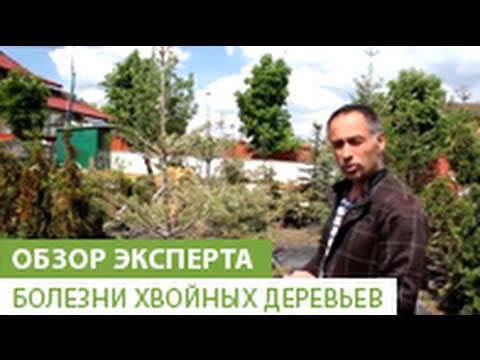

Watch this video on YouTube
Spruce propagation
Experts can propagate a spruce by grafting a stalk of an ornamental variety onto the stock of another coniferous tree, which has high winter hardiness. But among amateur gardeners, the most popular is the generative (seed) method of reproduction, as well as cuttings.
Growing spruce from seeds
The process of growing spruce from seed is quite long and labor-intensive. However, if time is not the main thing for a gardener, and possible difficulties do not frighten him, then he has every chance to grow a tree from seed.
Only freshly harvested seeds are sown. They should be pulled out of a mature bud that has not had time to open, but before that it should be dried. Before sowing, the seeds should be stratified. To do this, they are mixed with dry sand or with a mixture of sand and peat, and then put on the shelf of the refrigerator, where they will stay for 1–1.5 months at a temperature of 2-3 degrees. Sowing seeds is carried out in the last winter or the first spring weeks.Crops need abundant watering, while the containers are placed in a well-lit and warm place. After the seedlings appear, watering should be done more moderately. Seedlings are transplanted into open soil in the second year, while it is recommended to plant them immediately to a permanent place.
The seedlings of such a plant are characterized by extremely slow growth, and in addition to diseases and pests, direct sunlight, rain and strong gusts of wind can harm them.
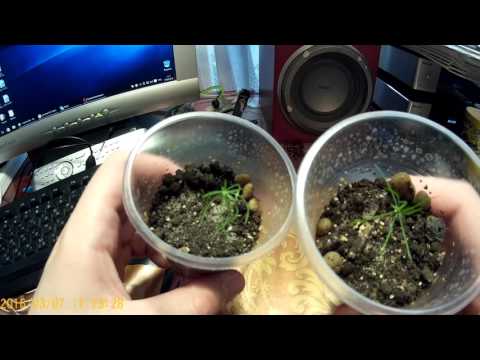

Watch this video on YouTube
Spruce propagation by cuttings
It is recommended to root the cuttings in the spring, and you need to be in time before the buds begin to swell on the trees. When harvesting cuttings with pruning shears, it is necessary to cut off the stems, reaching a length of 60–100 mm, while leaving them with twigs of the second order. Bottom cut of the cutting for 2 min. it is necessary to immerse the plant growth stimulating agent in the solution, then plant it at an angle of 20-30 degrees. For planting cuttings, a layer of soil mixture is used, which includes peat and sand (1: 3) or fine perlite and sand (1: 3), a five-centimeter drainage layer is laid on top of this substrate, which is covered from above with a layer of soddy earth about 10 centimeters thick. After planting, the cuttings must be moistened from a finely dispersed spray bottle, then the container must be covered with a transparent cap made of film on top, which will allow maintaining the required level of air humidity. Cuttings should be planted at a distance of at least 50 mm from each other, while the distance from the film surface to the tops of the cuttings should not be less than 25-30 centimeters. In the future, the cuttings will need fairly frequent and systematic spraying, while it is not recommended to moisturize the plant, but the film. It is impossible to spray cuttings in the evening. You also need to take into account that the air temperature in the mini-greenhouse should not be higher than 25 degrees, otherwise the cuttings may burn out. Small holes made in the film for ventilation will help to avoid this.
When the plants have developed their own root system, they are transplanted for growing. They can be transplanted into open soil after 1 year.
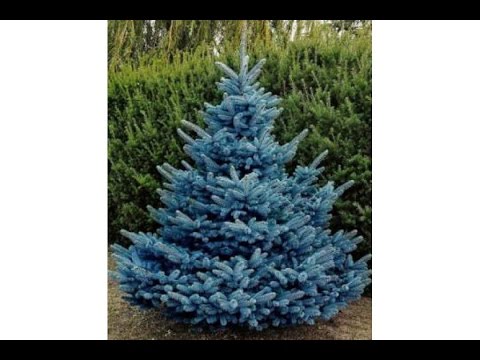

Watch this video on YouTube
Spruce in winter on the site
Features of care in the autumn
When buying seedlings of a Christmas tree, preference should be given to those that were grown in your region, in this case, such a tree will not have problems with frost resistance. It should be noted that exotic species that are thermophilic can die if there is little snow in the winter. The fir tree is distinguished by a rather high frost resistance, but this does not apply to such species as oriental spruce and Brevera spruce. However, it must be borne in mind that it is imperative to prepare a spruce for wintering, regardless of its type and variety.
The last water-charging irrigation is carried out before the first November frosts. To do this, under a tree whose height is less than 100 cm, 20 liters of water should be poured, and 30–50 liters of water should be poured under higher specimens. Most of all, one-year-old and two-year seedlings need such watering, the root system of which is still poorly developed, as well as spruce trees with low frost resistance and those trees that have undergone formative pruning in the current year. From the beginning of August, feeding the trees with nitrogen-containing fertilizers should be stopped, this will prevent young shoots from freezing in the winter. The fact is that nitrogen contributes to the intensive growth of the green mass, however, in the autumn, the spruce must direct all its strength to ensure that the already grown shoots have time to ripen before the frost begins. To speed up the process of lignification of the branches and make the root system of the tree stronger, it must be fed in September with potassium-phosphorus fertilizer, which must be applied to the soil of the trunk circle.
In order for the tree to survive the winter well, it is imperative to insulate the surface of the trunk circle; it is recommended to use tree bark as mulch. The bark is the best insulation for the spruce, because it does not impede the passage of air, as well as the evaporation of excess moisture, so the root system underneath it will definitely not dry out, as it can happen, for example, under sawdust or fallen leaves. Adult trees, as well as seedlings that have grown in a nursery located in your region, have a higher winter hardiness, and therefore the surface of the trunk circle does not need to be insulated.
Spruce wintering in the garden
In winter, the spruce lies in wait for many dangers. For example, when heavy snowfalls occur in winter and sleet sticks to the tree, the result is a high chance of skeletal branches breaking, as well as damage to thin branches. In order to remove snow from the plant, in no case do you need to shake the tree, because in winter the spruce branches are very fragile, and cracks can form on them. Those branches that you can reach should be freed from snow using a broom or a brush, while moving from the tip of the branch to the trunk. And the remaining branches, which are located relatively high, must be cleared of snow in a different way, for this it is necessary to take a long board, the end of which is wrapped with a soft cloth. With this stick, you need to pry on the branches one by one, and then gently swing them up and down. If the crown is columnar or has a spherical shape, then in the autumn, if desired, it can not be tightened very much, using twine for this, while the branches should be pressed as tightly as possible to the trunk, but they should not be pinched. Thanks to this, the branches will be protected from cracking. If in winter there is a sharp change in temperature at night and during the day, then an ice crust can form on the spruce paws, as a result of which they can bend strongly and crack. In this case, it is necessary to put supports under the branches (used to support the branches of fruiting crops in the summer), when it becomes warmer outside, the melted crust will slide off by itself.
Also for such trees, strong gusts of wind in winter are a great danger. They are especially dangerous for strong spruce trees, since such a wind can turn them out by the roots, while gusts of wind are not terrible for undersized species. You can try to protect a tall plant with stretch marks. To do this, at an equal distance from the tree on 4 sides, it is necessary to install powerful stakes, while their height should slightly exceed half the height of the tree. Stretching is done with twine, one of its ends is tied to the trunk of the plant, which must first be wrapped with roofing material, and the other end must be fixed on a stake. This procedure should be done with each of the stakes. It is recommended to install stakes in the autumn, while the soil is not frozen yet.
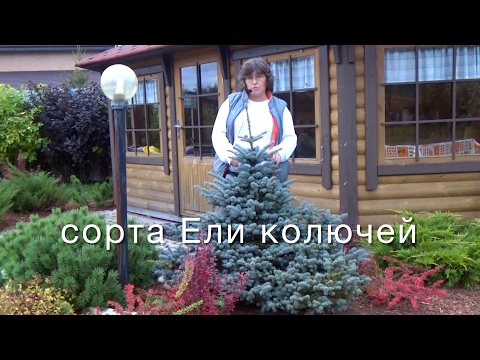

Watch this video on YouTube
Types and varieties of spruce with photos and names
There are only about 40 types of fir trees, most of which have decorative forms.
Ayan spruce (Picea ajanensis), or Hokkaid spruce
This ancient species can be found in the wild in the Far East. The height of this slender plant varies from 40 to 50 meters. The peaked crown has a regular conical shape. The young bark is smooth, while the more mature bark flakes off in plates. It is painted dark gray. The color of the shoots is brown-yellow, green-yellow or yellowish. The length of the flat needles is about 20 mm, their upper surface is dark green, and the lower one is deep-gray in color. The length of the decorative slightly shiny cones is about 65 mm, they have an oval-cylindrical shape and a pale brown color. This plant is resistant to frost and shade-loving, but it is demanding on the soil and can die in swampy soil. The maximum life span of such a tree is about 350 years.This species has a subspecies - the Khond spruce: it is not so tall and has greater resistance to return frost in spring, its leaf pads are more swollen, and the buds have a purple tint.
Brever Spruce (Picea breweriana)
This species is native to North America. The height of such a plant is from 20 to 25 meters, the trunk in diameter reaches from 0.45 to 0.75 meters. The branches of the second order are weeping. Resinous buds are elliptical or spindle-shaped. On the surface of young deeply grooved brownish-red shoots there is pubescence. After a while, their color changes to gray-silver. The length of the flattened needles, blunt at the apex, is 1.5–3 cm. The upper surface is green, and the lower one has rows of white stomata. Narrow-cylindrical cones have a cut off top edge and a length of 60 to 100 mm. Their scales are very thick and during ripening they open very wide. On the territory of Europe, this species is cultivated relatively rarely.
Oriental spruce (Picea orientalis)
This species is one of the forest-forming species of the Caucasian forests, even in nature it can be found in the server countries of Asia Minor. The height of such a tree varies from 35 to 50 meters, while its diameter is about 2 meters. The branchy lush crown has a conical shape. The color of the scaly bark is dark gray or brown. The color of young densely pubescent shoots is light red or yellow-gray, and mature ones are grayish or gray. The tetrahedral short, very shiny needles are slightly flattened, and blunt at the apex. The length of the purple spindle-cylindrical cones is about 10 centimeters, over time, their color changes to pale brown. It has been cultivated since 1837. The frost resistance of this species is low. The best decorative forms of this kind:
- Aurea (Aureaspikata)... Crohn narrow conical. The lateral drooping branches are asymmetric. The tree reaches a height of 10-12 meters, and the diameter of its crown is 4 to 6 meters. The color of the needles on young shoots is pale golden, over time it changes to dark green, and the needles become glossy and tough.
- Earley Gold... This shape is similar to Aurea, however, its needles turn yellow-green over time.
- Skylands (Aurea Compact)... This form is one of the most popular varieties of this species. All the year round, the needles on such spruce are painted golden. The height of the plant is about 11 meters, the shape of the crown is pyramidal, and the needles are dense and short.
- Natanz... Plant height is about 20 meters. The dense crown includes hanging weeping branches. Dark green lush short needles are glossy and tough. The color of young cones is purple, but over time it changes to brown.
The best miniature forms of this type:
- Bergmanz Jam... The height of a tree with dark green needles does not exceed 0.6 m, while the crown reaches 0.9 m in diameter. In a young plant, the crown has an elongated shape, which eventually changes to a spherical, and then to a pillow-shaped one.
- Professor Lengner... The height of the tree and its diameter is about 0.3 m. The spherical crown is very dense, the short needles are painted in a dark green color.
Korean spruce (Picea koraiensis)
This species is native to North Korea and the Far East, it is protected in reserves. The height of such a tree is about 30 meters. The shape of the crown is pyramidal, it consists of drooping branches. The color of the bark is brown-red. Young shoots are colored light brown or yellow, which, as they grow, changes to brown-red. Green needles reach 0.9–2.2 cm in length. The length of the oblong-ovate cones is 80–100 mm. This type is recommended by experts for landscaping, as it is very resistant to adverse environmental factors. But in the middle latitudes, the cultivation of this species is still in the future.
Black spruce (Picea mariana)
This plant is native to North America. Its height is 20 to 30 meters, and the trunk girth is 0.3–0.9 meters. The narrow crown has an irregularly conical shape.Brown-red or brown-gray thin bark, fissured and scaly. On the surface of brown-red young shoots there is glandular pubescence. Compared to other types of trees, this one has very thin needles, their lower surface is dark green-blue, and the upper surface has stomatal lines. Small globular or ovoid buds are brownish-purple when young, and then fade and turn brown. This species is shade-loving, frost-resistant and undemanding to the ground. It has been cultivated on the territory of Europe since 1700. This species is slightly inferior only to Canadian spruce in decorativeness. Forms of this type:
- Baysneri... The height and diameter of the crown of such a cultivar is about 5 meters. The color of the needles is bluish-silver. There is a compact version - Baysneri Compact: height about 200 cm.
- Doume... The height of the frost-resistant tree is about 6 meters. The lush crown has a wide conical shape. There are many ascending branches. The bluish needles are very lush. Cones grow on the trunk of the plant.
- Kobold... This hybrid is created using Serbian spruce and Doumeti form. The height and diameter of this tree is about 100 cm. The lush crown has a spherical shape. The needles are dark green.
- Nana... This graceful dwarf form of half a meter in height is winter hardiness. The shape of the uniform crown is rounded. Thin needles have a pale blue-green color.
Also, this species has varieties: Aurea, Erikoides, Empetroides and Pendula.
Norway spruce (Picea abies), or European spruce
The homeland of this species is Europe. The tree is about 50 meters tall, but most specimens do not grow taller than 35 meters. The trunk reaches 100–150 cm in diameter. The cone-shaped crown has spaced or drooping branches that rise at the tips. The thin brownish-red or gray bark can be smooth or fissured. The color of bare shoots is brownish or rusty yellow. Ovate-conical buds are brownish. The length of the needles is 8–20 mm, they are tetrahedral glossy dark green, and pointed at the top. The needles do not fall off the branches for 6–12 years. The length of the oblong-ovoid cones is from 10 to 16 centimeters, at first they are greenish or dark purple, and then they become brown. The average age of this species is from 250 to 300 years, but the tree can live up to 500 years. Forms of this type are divided according to the types of branching:
- comb - branches of the first order are horizontal, and of the second - thin, they are placed in a comb and hang down;
- incorrectly combed - the branches of the second order are placed combed, but incorrectly;
- compact - the branches of the first order are of medium length, and they are densely covered with branched branches of the second order;
- flat - branches of the first order are widely branched in the horizontal direction;
- brush-like - branches of the first order have thick, short branches with brush-like small branches hanging down.
The following forms of this type are also quite popular:
- Akrokona... This variety was developed in Finland. It has moderate winter hardiness. The height of the tree is from 2 to 3 meters. The shape of the crown is broadly conical, and its diameter is from 2 to 4 meters. The smooth pale brown bark becomes rough and brownish red over time. Pointed tetrahedral needles are dark green in color. The cones are cylindrical in shape.
- Repair... The height of this undersized form is about 300 cm. The shape of the dense crown is ovoid or conical. The egg buds are orange in color and the needles are green.
- Pumila Glauka... The height of the dwarf plant is about 100 cm. The rounded-flattened crown reaches 5 to 6 meters in diameter. Shoots overlap each other and droop a little at the top. Dark green needles have a bluish tint.
The following varieties of this type are also quite popular: Aurea, Aurea Magnifica, Berry, Clanbrassiliana, Columnaris, Compact, Konica, Cranstoni, Kupressiana, Ehiniformis, Krasnoplodnaya, Formanek, Gregoriana, Inversa, Little Gem, Maxwelli, Microfidorlaformi, Nana, Nana Pyramidata, Pygmy, Procumbens, Pumila, Reflexa, Repens, Tabuliformis, Viminalis, Virgata, Will Zwerg, etc.
The following types of spruce are also cultivated: Glena, Canadian (or gray, or white), prickly, Koyami, red, Lizian, Lutza, Maksimovich, Meyer, spruce, Serbian, Siberian, Sitka, Finnish, Tien Shan (Shrenka), rough, Engelman and others, as well as many of their varieties.
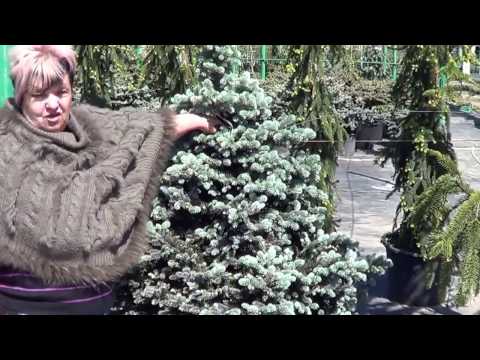

Watch this video on YouTube

